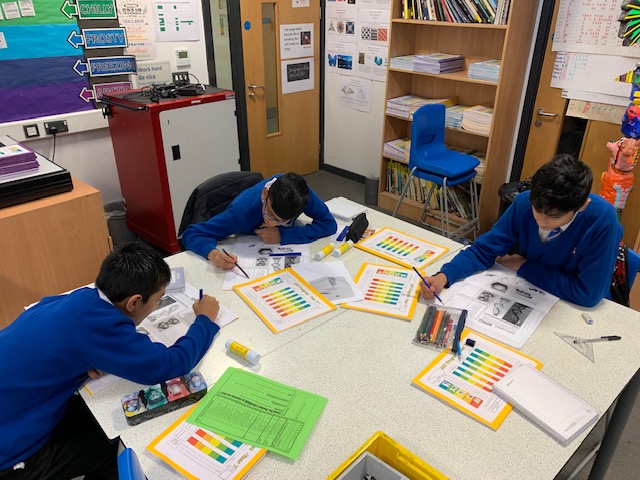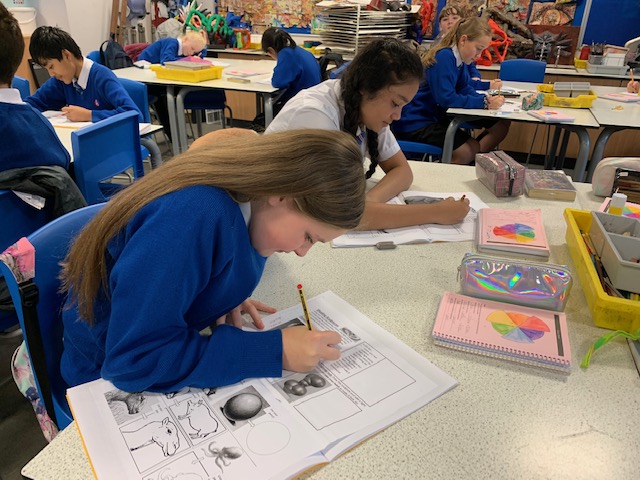Year 7 Art
During year 7, the following topics are covered:
- Tone
- Colour Mixing
- Colour Artist
- Cubism
- Impressionism
- Masks

Tone/Markmaking
An introduction to the key elements of drawing, mark making and tone. Pupils will complete a series of tasks aimed at developing their understanding of tone/shading and refining their pencil control.
Colour Theory
This unit allows our students to gain an understanding of basic colour theory. Using the colour wheel, pupils will practise mixing watercolour paints effectively and understanding how to achieve a wide range of tones and shades. Technical skills will then be developed to ensure that pupils learn about successful application of the media, ready to create pieces of artwork.
Colour Artists
Pupils will study and compare the work of a number of well known colour artists. After a series of workshops/ tasks, pupils will endeavour to emulate the artist’s style using their newly acquired skills and knowledge.
Cubism
This project will expose pupils to the Cubism movement. We will learn how to incorporate geometric shapes into designs, in order to create interesting and individual artwork. The style of cubist work will be used to influence the structure of design ideas as well as the use of blended colour application.
Impressionism
During this unit pupils will become aware of the work of artists such as George Seurat and other known for their Impressionist work. We will study how their use of mark making and colour sets their work apart from that of others. Pupils will conduct a series of technique building tasks, aimed at developing their skills in this interesting and exciting genre of art.
Masks
Masks have long been part of cultures from around the world. During this project pupils will investigate and compare masks from various locations and learn about their significance, visually and culturally. A series of original designs will then be made, taking world masks as inspiration, before pupils then create a final piece using newly acquired 3D modelling skills.
Year 8 Art
During year 8, the following topics are covered:
- Environmental Art/ Hundertwasser
- Portraiture
- African Masks/Adinkra Symbols
- Stained Glass
- Graffitti
- Insects

Environmental Art/ Hundertwasser
This unit allows students to contextually analyse the line, pattern and colours of Hundertwasser’s artwork through teacher lead workshops. This extends their knowledge and understanding of how an artist works.
Students revisit and strengthen painting techniques learned in year 7. They will further their skills in mixing and applying watercolour and create a composition of their own design inspired by the artist’s style.
Portraiture
Students learn, practice and master the basic drawing rules of portraiture in this unit, by following step by step teacher lead drawing demonstrations. These will cover eyes, nose and mouth drawing techniques. Students also learn how to mix skin tone in paint and practice applying this to their drawing.
Students are introduced to the work of Modigliani will compare and contrast his style to the classic proportion rules they have learned. Students will then create their own stylised version of Modigliani portrait.
African Masks/Adinkra Symbols
In this unit students gain an appreciation of the spiritual and cultural importance of masks. They consider the materials used as well as exploring the artistic influences. By extending the unit further into Adinkra symbols, students gain a wider understanding of the traditional craftsmanship and a knowledge of how traditional printing takes place. By personally developing their own Adinkra style symbol, students have the opportunity to work in card, paper mache, paint and gold leaf to create a 3D relief outcome.
Stained Glass
In this unit students consider the traditional craftsmanship of stained glass windows and learn how Stained Glass windows are made and used in context. Building on design skills, students draw an animal or bird and carefully divide it into sections (which would be pieces of glass). Students go through a design process of tracing their image and applying carefully blended oil pastels before the work is laminated and outlined, giving the effect of a stained glass window.
Graffitti
Our Graffiti Unit allows students to revisit and consolidate key skills of drawing, pencil crayon blending and image and text. By looking at highly contemporary artists students are drawn into debate about the rights and wrongs of graffiti. Workshop lessons are delivered to give students the tools to practice and master the right techniques in layering, blending and shadowing. This allows them to design and create their own colourful graffiti inspired piece.
Insects
By using Insects as the theme for this unit students are given the chance to test and extend their skills in observational pencil drawing. Studying the complex body structure of bugs allows students to design and develop their own unique insect. Drawing techniques are explored and challenged further by using a match stick and inks to develop mark making skills used in year 7. 2D insect designs are then created as a 3D sculpture.
Year 9 Art
During year 9, the following topics are covered:
- Surrealism
- Egyptian Art
- Tattoos
- Architecture
- Conceptual Art
- Pop Art
- Anime/Manga

Surrealism
This project is an introduction to the expressive world of Surrealism. During this topic, students will learn about the work of key artists within this movement and will complete a series of tasks. The techniques covered will allow for a more relaxed attitude to line and tone in the form of automatic drawing.
Egyptian Art
Pupils will gain an understanding of ancient Egyptian Artwork and use their design skills to create a scarab beetle brooch using figures/gods from Egyptian history. The design will be realised as an original finely carved scraperboard artwork.
Tattoos
Students will learn about the origins of Tattoos and how they have always had cultural significance in certain areas of the world. After studying the appearance and structure of a range of tattoo types, pupils will then refine their drawing skills and then design create their own unique pieces
Architecture
Pupils will demonstrate that they can look at the work of other artists/architects and use ideas from them in their own work. They will make key decisions about what they want to include in their architecturally inspired art work and explain where they got their inspiration from. A number of original designs will me made and then a final piece which showcases their design/technical skills.
Conceptual Art
Pupils will be introduced to the exciting world of conceptual art and famous artists, such as Damien Hirst and Tracey Emin.
By questioning this type of artwork, pupils will be encouraged to understand the notion that anything can be art.
They will then demonstrate that they can use similar ways of thinking in order to develop a series of potential designs, which could be developed into a finished version.
Pop Art
Pupils will revisit POP ART (briefly looked at in yr7) and gain a more in depth understanding of this highly influential and fun art movement.
Pupils will demonstrate that they can be influenced by this type of work, by observing the style and then making their own original creations using the leading pop artists as inspiration.
Anime/Manga
During this project students will complete a series of drawing tasks which will develop their understanding of how to draw characters successfully. Pupils will then be encouraged to create their own characters whilst using proportion as a tool to depict movement in an image.










